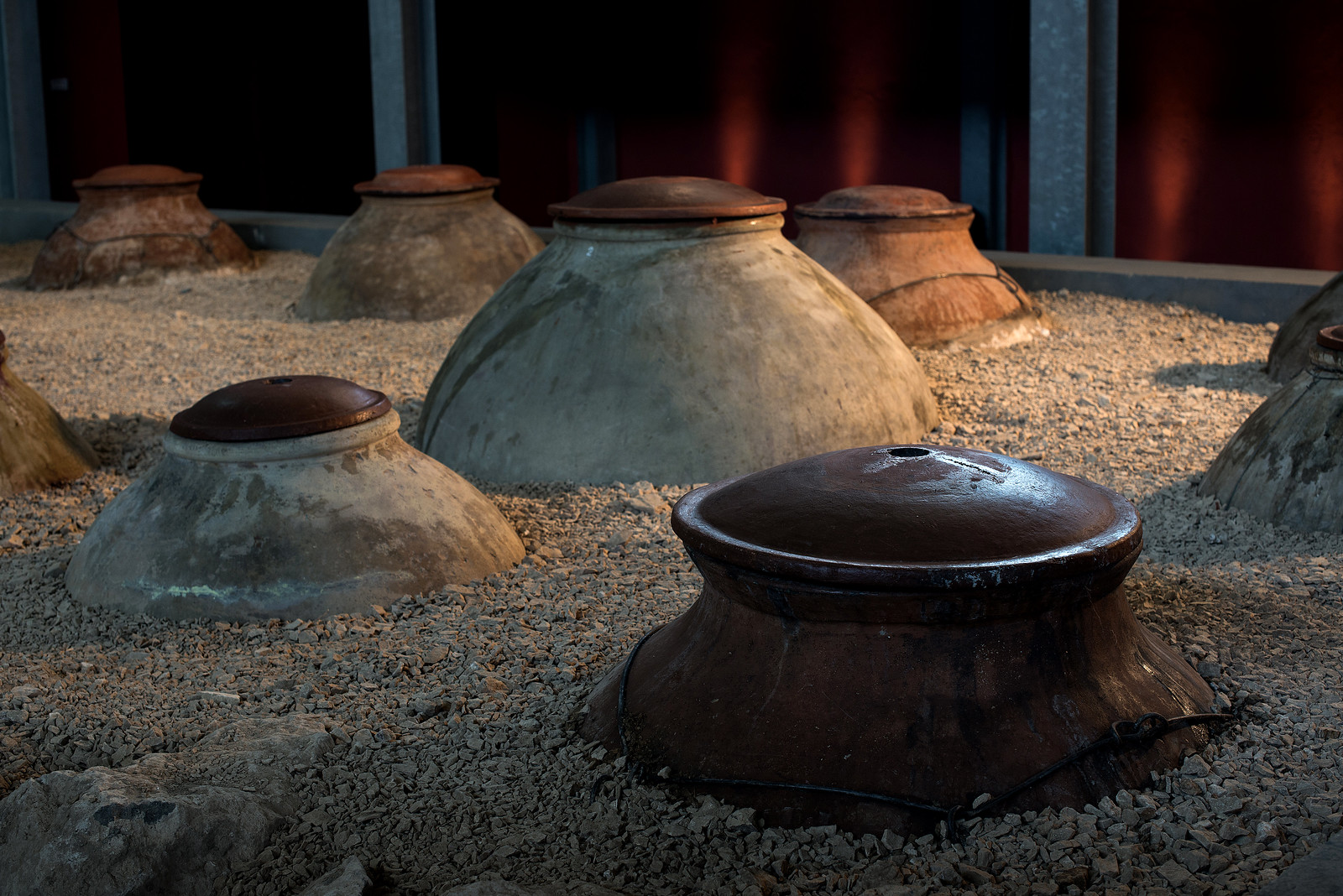
The art and science of wine aging in traditional vessels represents one of humanity's earliest applications of complex physical principles to food preservation and enhancement. From the amphoras of ancient Kemet to the qvevri of Georgia, these vessels demonstrate sophisticated understanding of temperature regulation, material properties, and time-dependent processes. This analysis explores the intricate relationships between physical forces, environmental factors, and wine development in traditional vessel aging.
Temperature Dynamics
Underground Advantage The practice of burying wine vessels, documented in civilizations from ancient Egypt to medieval Europe, leverages several crucial physical properties of soil environments:
Natural Regulation The soil's capacity to maintain stable temperatures provides a natural regulatory system that protects wine from harmful temperature fluctuations. At depths typically used for wine storage (1.5-3 meters), temperature variations remain within 2-3°C annually, compared to surface fluctuations of 20°C or more.
Soil Temperature Properties * Thermal mass: Surrounding soil provides substantial thermal inertia * Diurnal buffering: Elimination of daily temperature cycles * Seasonal moderation: Reduced impact of extreme weather events * Depth-dependent stability: Increasing consistency with depth
Vessel Properties The physical characteristics of traditional wine vessels play a crucial role in wine development and preservation:
Material Physics Traditional materials like clay, limestone, and ceramic demonstrate specific advantages: * Thermal conductivity optimized for gradual temperature changes * Heat capacity supporting temperature stability * Porosity enabling controlled gas exchange * Surface area to volume ratios promoting ideal aging conditions
Structural Considerations Vessel design reflects sophisticated understanding of physical principles: * Wall thickness variations for temperature control * Shape optimization for thermal distribution * Surface texture effects on fluid dynamics * Volume distribution impact on wine movement
Time-Dependent Processes
Short-Term Dynamics The daily and weekly cycles in traditional vessels create unique conditions for wine development:
Daily Cycles * Minimal temperature fluctuation (typically <1°C) * Controlled thermal expansion and contraction * Natural fluid movement promoting uniform aging * Regulated gas exchange through vessel walls
Weekly Patterns * Steady fermentation kinetics * Balanced heat accumulation and dissipation * Stable temperature maintenance * Consistent energy distribution
Long-Term Effects The extended aging process in traditional vessels produces complex developmental patterns:
Seasonal Impact * Annual temperature cycles promote steady development * Cumulative effects on wine character * Progressive aging patterns * Quality development through natural cycles
Multi-Year Evolution * Vessel conditioning improving performance * Material adaptation to wine interaction * Enhanced efficiency through repeated use * Development of beneficial microflora
Physical Processes
Heat Transfer Mechanisms The movement of thermal energy through traditional vessels follows established physical principles:
Conduction * Wall conductivity optimized for wine preservation * Gradient-driven energy flow * Material-specific thermal properties * Balanced energy distribution
Convection * Natural fluid movement patterns * Heat distribution through wine mass * Thermal stratification management * Flow pattern optimization
Mass Transfer The exchange of materials through vessel walls significantly impacts wine development:
Gas Exchange * Controlled oxygen permeation * Carbon dioxide management * Vapor transfer regulation * Pressure equilibration
Liquid Movement * Capillary action in porous materials * Pressure-driven flow * Surface tension effects * Dynamic fluid patterns
Environmental Considerations
External Conditions The interaction between vessels and their environment shapes wine development:
Ambient Factors * Regional climate adaptation * Seasonal variation management * Daily fluctuation buffering * Extreme event protection
Soil Properties * Thermal conductivity utilization * Moisture content regulation * Density effects on temperature * Composition impact on stability
Internal Environment The conditions within vessels create unique developmental spaces:
Vessel Atmosphere * Humidity control through porosity * Gas composition regulation * Pressure equilibrium maintenance * Temperature uniformity promotion
Wine Interaction * Thermal stratification management * Density-driven circulation * Surface interaction effects * Volume-dependent processes
Measurement and Monitoring
Traditional Methods Historical approaches to vessel monitoring demonstrate sophisticated observational techniques:
Temperature Assessment * Manual measurement practices * Visual inspection protocols * Experience-based evaluation * Pattern recognition development
Time Tracking * Process documentation methods * Temperature recording systems * Event monitoring practices * Pattern analysis techniques
Quality Impact
Temperature Effects The thermal environment significantly influences wine development:
Wine Development * Controlled extraction rates * Optimal fermentation conditions * Steady aging progression * Character enhancement
Stability Factors * Microbial environment control * Chemical stability maintenance * Physical stability promotion * Quality preservation methods
Future Applications
Technical Innovation Modern applications of traditional principles offer new possibilities:
Monitoring Systems * Sensor integration opportunities * Data collection methods * Analysis system development * Control mechanism implementation
Process Optimization * Temperature management enhancement * Time efficiency improvement * Quality control advancement * Resource use optimization
Conclusion The physics of traditional wine vessels represents a remarkable integration of natural processes and human ingenuity. Understanding these principles provides crucial insights for both preserving historical methods and developing sustainable modern practices. As contemporary winemaking faces new challenges from climate change and resource constraints, the wisdom embedded in these ancient technologies offers valuable lessons for future innovation.
The complex interplay of temperature, time, and material properties in traditional vessels continues to demonstrate the sophistication of historical winemaking practices. By studying and applying these principles, modern vintners can develop more sustainable and effective approaches to wine production and aging.
